Blog & Latest Updates
Fly Fishing Articles
Insects by Common Name


Updates from February 7, 2004
Videos by Troutnut from the Namekagon River in Wisconsin
Pteronarcys
Starring: Pteronarcys dorsata Stonefly Nymph
StateWisconsin
LocationNamekagon River
Date ShotFeb 7, 2004
Date AddedMar 31, 2006
AuthorTroutnut
CameraOlympus C740UZ
Closeup insects by Troutnut from Miscellaneous Wisconsin and the Namekagon River in Wisconsin
Pteronarcys dorsata (Giant Black Stonefly) Stonefly Nymph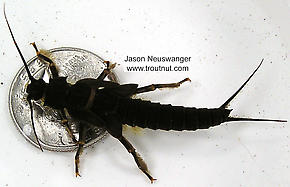 View 8 Pictures
View 8 Pictures
 View 8 Pictures
View 8 PicturesCollected February 7, 2004 from the Namekagon River in Wisconsin
Added to Troutnut.com by Troutnut on January 25, 2006
Added to Troutnut.com by Troutnut on January 25, 2006
Ephemerella subvaria (Hendrickson) Mayfly Nymph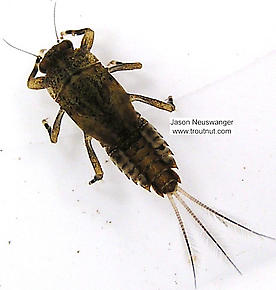 View 7 PicturesThis is another unusual brown Ephemerella nymph. The "fan-tail" which defines the Ephemerella genus is particularly evident on this specimen.
View 7 PicturesThis is another unusual brown Ephemerella nymph. The "fan-tail" which defines the Ephemerella genus is particularly evident on this specimen.
 View 7 PicturesThis is another unusual brown Ephemerella nymph. The "fan-tail" which defines the Ephemerella genus is particularly evident on this specimen.
View 7 PicturesThis is another unusual brown Ephemerella nymph. The "fan-tail" which defines the Ephemerella genus is particularly evident on this specimen.Collected February 7, 2004 from unknown in Wisconsin
Added to Troutnut.com by Troutnut on January 25, 2006
Added to Troutnut.com by Troutnut on January 25, 2006
Epeorus vitreus (Sulphur) Mayfly Nymph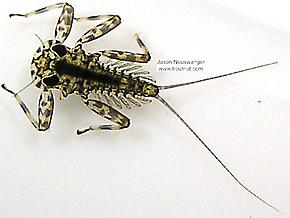 View 6 Pictures
View 6 Pictures
 View 6 Pictures
View 6 PicturesCollected February 7, 2004 from unknown in Wisconsin
Added to Troutnut.com by Troutnut on January 25, 2006
Added to Troutnut.com by Troutnut on January 25, 2006
Ephemerella (Hendricksons, Sulphurs, PMDs) Mayfly Nymph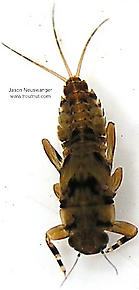 View 6 PicturesThis pretty Ephemerella nymph has really weird markings. It has one band on the tibiae (
View 6 PicturesThis pretty Ephemerella nymph has really weird markings. It has one band on the tibiae (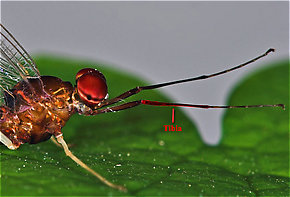 Tibia: A middle segments in the leg of an insect, located between the femur and the tarsus.) and a thin but distinct dorsal (Dorsal: Top.) stripe faded in the center which looks very different from the stripes on Ephemerella needhami and Ephemerella aurivillii. It definitely has the fan tail characteristic of the Ephemerella genus.
Tibia: A middle segments in the leg of an insect, located between the femur and the tarsus.) and a thin but distinct dorsal (Dorsal: Top.) stripe faded in the center which looks very different from the stripes on Ephemerella needhami and Ephemerella aurivillii. It definitely has the fan tail characteristic of the Ephemerella genus.
 View 6 PicturesThis pretty Ephemerella nymph has really weird markings. It has one band on the tibiae (
View 6 PicturesThis pretty Ephemerella nymph has really weird markings. It has one band on the tibiae (
The tibia of this Isonychia bicolor mayfly spinner is highlighted in red.
Collected February 7, 2004 from unknown in Wisconsin
Added to Troutnut.com by Troutnut on January 25, 2006
Added to Troutnut.com by Troutnut on January 25, 2006
Paraleptophlebia (Blue Quills and Mahogany Duns) Mayfly Nymph View 6 Pictures
View 6 Pictures
 View 6 Pictures
View 6 PicturesCollected February 7, 2004 from unknown in Wisconsin
Added to Troutnut.com by Troutnut on January 25, 2006
Added to Troutnut.com by Troutnut on January 25, 2006
Eurylophella (Chocolate Duns) Mayfly Nymph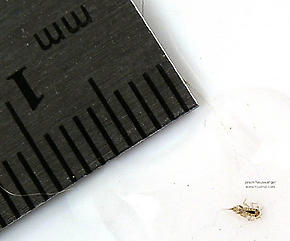 View 5 PicturesThis nymph is an extremely early instar (Instar: Many invertebrates molt through dozens of progressively larger and better-developed stages as they grow. Each of these stages is known as an instar. Hard-bodied nymphs typically molt through more instars than soft-bodied larvae.).
View 5 PicturesThis nymph is an extremely early instar (Instar: Many invertebrates molt through dozens of progressively larger and better-developed stages as they grow. Each of these stages is known as an instar. Hard-bodied nymphs typically molt through more instars than soft-bodied larvae.).
 View 5 PicturesThis nymph is an extremely early instar (Instar: Many invertebrates molt through dozens of progressively larger and better-developed stages as they grow. Each of these stages is known as an instar. Hard-bodied nymphs typically molt through more instars than soft-bodied larvae.).
View 5 PicturesThis nymph is an extremely early instar (Instar: Many invertebrates molt through dozens of progressively larger and better-developed stages as they grow. Each of these stages is known as an instar. Hard-bodied nymphs typically molt through more instars than soft-bodied larvae.).Collected February 7, 2004 from unknown in Wisconsin
Added to Troutnut.com by Troutnut on January 25, 2006
Added to Troutnut.com by Troutnut on January 25, 2006
Baetidae (Blue-Winged Olives) Mayfly Nymph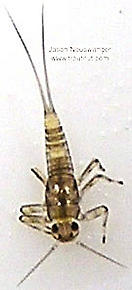 View 5 PicturesThis nymph has only two real tails. The third is present, but too short to see in these pictures. It has particularly small gills and indistinct gill veinlets (Veinlet: Short insect wing veins connecting the major longitudinal veins to the wing margin.).
View 5 PicturesThis nymph has only two real tails. The third is present, but too short to see in these pictures. It has particularly small gills and indistinct gill veinlets (Veinlet: Short insect wing veins connecting the major longitudinal veins to the wing margin.).
 View 5 PicturesThis nymph has only two real tails. The third is present, but too short to see in these pictures. It has particularly small gills and indistinct gill veinlets (Veinlet: Short insect wing veins connecting the major longitudinal veins to the wing margin.).
View 5 PicturesThis nymph has only two real tails. The third is present, but too short to see in these pictures. It has particularly small gills and indistinct gill veinlets (Veinlet: Short insect wing veins connecting the major longitudinal veins to the wing margin.).Collected February 7, 2004 from unknown in Wisconsin
Added to Troutnut.com by Troutnut on January 25, 2006
Added to Troutnut.com by Troutnut on January 25, 2006
Rhyacophila brunnea (Green Sedge) Caddisfly Larva View 4 Pictures
View 4 Pictures
 View 4 Pictures
View 4 PicturesCollected February 7, 2004 from unknown in Wisconsin
Added to Troutnut.com by Troutnut on January 25, 2006
Added to Troutnut.com by Troutnut on January 25, 2006
Dolophilodes distinctus (Tiny Black Gold Speckled-Winged Caddis) Caddisfly Larva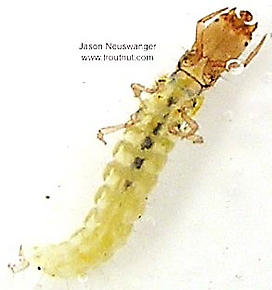 View 4 Pictures
View 4 Pictures
 View 4 Pictures
View 4 PicturesCollected February 7, 2004 from unknown in Wisconsin
Added to Troutnut.com by Troutnut on January 25, 2006
Added to Troutnut.com by Troutnut on January 25, 2006
Cyprinidae (Minnows) Minnow Adult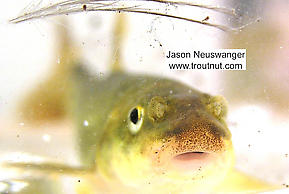 View 4 PicturesLongnose Dace
View 4 PicturesLongnose Dace
Rhinichthys cataractae
 View 4 PicturesLongnose Dace
View 4 PicturesLongnose DaceRhinichthys cataractae
Collected February 7, 2004 from unknown in Wisconsin
Added to Troutnut.com by Troutnut on January 25, 2006
Added to Troutnut.com by Troutnut on January 25, 2006
Ephemerella subvaria (Hendrickson) Mayfly Nymph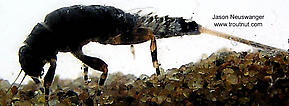 View 4 PicturesHere's one of the darkest E. subvaria nymphs I've seen.
View 4 PicturesHere's one of the darkest E. subvaria nymphs I've seen.
 View 4 PicturesHere's one of the darkest E. subvaria nymphs I've seen.
View 4 PicturesHere's one of the darkest E. subvaria nymphs I've seen.Collected February 7, 2004 from unknown in Wisconsin
Added to Troutnut.com by Troutnut on January 25, 2006
Added to Troutnut.com by Troutnut on January 25, 2006
Cyprinidae (Minnows) Minnow Adult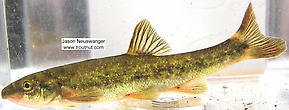 View 4 PicturesLongnose Dace
View 4 PicturesLongnose Dace
Rhinichthys cataractae
 View 4 PicturesLongnose Dace
View 4 PicturesLongnose DaceRhinichthys cataractae
Collected February 7, 2004 from unknown in Wisconsin
Added to Troutnut.com by Troutnut on January 25, 2006
Added to Troutnut.com by Troutnut on January 25, 2006
Paragnetina media (Embossed Stonefly) Stonefly Nymph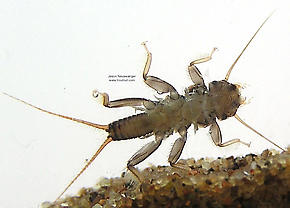 View 4 Pictures
View 4 Pictures
 View 4 Pictures
View 4 PicturesCollected February 7, 2004 from unknown in Wisconsin
Added to Troutnut.com by Troutnut on January 25, 2006
Added to Troutnut.com by Troutnut on January 25, 2006
Ephemerella invaria (Sulphur Dun) Mayfly Nymph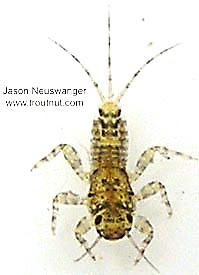 View 4 PicturesI looked at this small Ephemerella nymph very carefully under a microscope. It as no abdominal tubercles (
View 4 PicturesI looked at this small Ephemerella nymph very carefully under a microscope. It as no abdominal tubercles (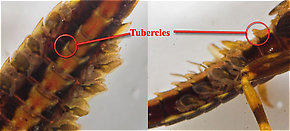 Tubercle: Various peculiar little bumps or projections on an insect. Their character is important for the identification of many kinds of insects, such as the nymphs of Ephemerellidae mayflies.) and 1-banded tibiae (
Tubercle: Various peculiar little bumps or projections on an insect. Their character is important for the identification of many kinds of insects, such as the nymphs of Ephemerellidae mayflies.) and 1-banded tibiae ( Tibia: A middle segments in the leg of an insect, located between the femur and the tarsus.). I think just a very early instar (Instar: Many invertebrates molt through dozens of progressively larger and better-developed stages as they grow. Each of these stages is known as an instar. Hard-bodied nymphs typically molt through more instars than soft-bodied larvae.) invaria nymph.
Tibia: A middle segments in the leg of an insect, located between the femur and the tarsus.). I think just a very early instar (Instar: Many invertebrates molt through dozens of progressively larger and better-developed stages as they grow. Each of these stages is known as an instar. Hard-bodied nymphs typically molt through more instars than soft-bodied larvae.) invaria nymph.
 View 4 PicturesI looked at this small Ephemerella nymph very carefully under a microscope. It as no abdominal tubercles (
View 4 PicturesI looked at this small Ephemerella nymph very carefully under a microscope. It as no abdominal tubercles (
A few (not all) of the abdominal tubercles on this Ephemerella needhami nymph are circled. They are especially large in this species.

The tibia of this Isonychia bicolor mayfly spinner is highlighted in red.
Collected February 7, 2004 from unknown in Wisconsin
Added to Troutnut.com by Troutnut on January 25, 2006
Added to Troutnut.com by Troutnut on January 25, 2006
Isonychia bicolor (Mahogany Dun) Mayfly Nymph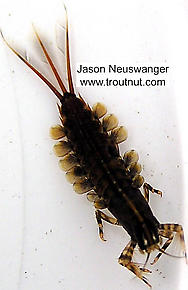 View 4 Pictures
View 4 Pictures
 View 4 Pictures
View 4 PicturesCollected February 7, 2004 from the Namekagon River in Wisconsin
Added to Troutnut.com by Troutnut on January 25, 2006
Added to Troutnut.com by Troutnut on January 25, 2006
Paraleptophlebia (Blue Quills and Mahogany Duns) Mayfly Nymph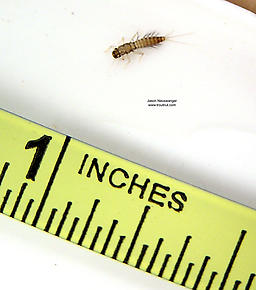 View 4 PicturesLooking at this one under the microscope, I noted that is has untracheated gills which fork 1/3 of the way from the base and postero-lateral (Lateral: To the side.) spines on abdominal segment 9
View 4 PicturesLooking at this one under the microscope, I noted that is has untracheated gills which fork 1/3 of the way from the base and postero-lateral (Lateral: To the side.) spines on abdominal segment 9
 View 4 PicturesLooking at this one under the microscope, I noted that is has untracheated gills which fork 1/3 of the way from the base and postero-lateral (Lateral: To the side.) spines on abdominal segment 9
View 4 PicturesLooking at this one under the microscope, I noted that is has untracheated gills which fork 1/3 of the way from the base and postero-lateral (Lateral: To the side.) spines on abdominal segment 9Collected February 7, 2004 from unknown in Wisconsin
Added to Troutnut.com by Troutnut on January 25, 2006
Added to Troutnut.com by Troutnut on January 25, 2006
Acroneuria carolinensis (Golden Stone) Stonefly Nymph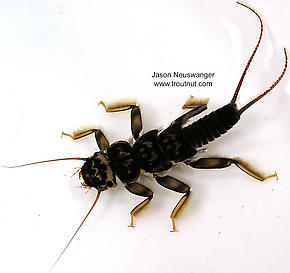 View 3 Pictures
View 3 Pictures
 View 3 Pictures
View 3 PicturesCollected February 7, 2004 from unknown in Wisconsin
Added to Troutnut.com by Troutnut on January 25, 2006
Added to Troutnut.com by Troutnut on January 25, 2006
Leucrocuta hebe (Little Yellow Quill) Mayfly Nymph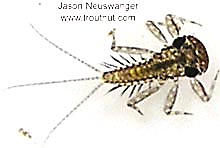 View 3 PicturesThis is a very early instar (Instar: Many invertebrates molt through dozens of progressively larger and better-developed stages as they grow. Each of these stages is known as an instar. Hard-bodied nymphs typically molt through more instars than soft-bodied larvae.).
View 3 PicturesThis is a very early instar (Instar: Many invertebrates molt through dozens of progressively larger and better-developed stages as they grow. Each of these stages is known as an instar. Hard-bodied nymphs typically molt through more instars than soft-bodied larvae.).
 View 3 PicturesThis is a very early instar (Instar: Many invertebrates molt through dozens of progressively larger and better-developed stages as they grow. Each of these stages is known as an instar. Hard-bodied nymphs typically molt through more instars than soft-bodied larvae.).
View 3 PicturesThis is a very early instar (Instar: Many invertebrates molt through dozens of progressively larger and better-developed stages as they grow. Each of these stages is known as an instar. Hard-bodied nymphs typically molt through more instars than soft-bodied larvae.).Collected February 7, 2004 from unknown in Wisconsin
Added to Troutnut.com by Troutnut on January 25, 2006
Added to Troutnut.com by Troutnut on January 25, 2006
Calopteryx Damselfly Nymph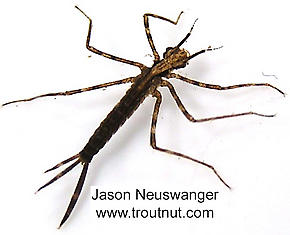 View 3 Pictures
View 3 Pictures
 View 3 Pictures
View 3 PicturesCollected February 7, 2004 from unknown in Wisconsin
Added to Troutnut.com by Troutnut on January 25, 2006
Added to Troutnut.com by Troutnut on January 25, 2006
Capniidae (Snowflies) Stonefly Nymph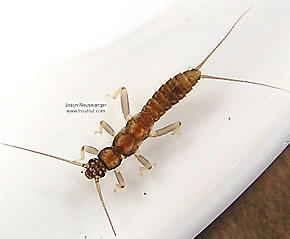 View 3 Pictures
View 3 Pictures
 View 3 Pictures
View 3 PicturesCollected February 7, 2004 from unknown in Wisconsin
Added to Troutnut.com by Troutnut on January 25, 2006
Added to Troutnut.com by Troutnut on January 25, 2006
Maccaffertium vicarium (March Brown) Mayfly Nymph View 3 Pictures
View 3 Pictures
 View 3 Pictures
View 3 PicturesCollected February 7, 2004 from unknown in Wisconsin
Added to Troutnut.com by Troutnut on January 25, 2006
Added to Troutnut.com by Troutnut on January 25, 2006
Ptychopteridae (Phantom Crane Flies) Phantom Crane Fly Larva View 3 Pictures
View 3 Pictures
 View 3 Pictures
View 3 PicturesCollected February 7, 2004 from unknown in Wisconsin
Added to Troutnut.com by Troutnut on January 25, 2006
Added to Troutnut.com by Troutnut on January 25, 2006
Baetisca laurentina (Armored Mayfly) Mayfly Nymph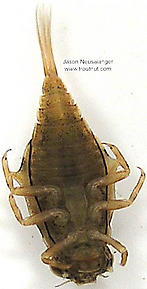 View 3 Pictures
View 3 Pictures
 View 3 Pictures
View 3 PicturesCollected February 7, 2004 from unknown in Wisconsin
Added to Troutnut.com by Troutnut on January 25, 2006
Added to Troutnut.com by Troutnut on January 25, 2006
Ephemerella subvaria (Hendrickson) Mayfly Nymph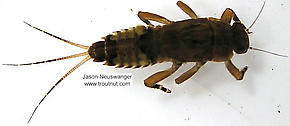 View 3 PicturesHere's another nymph with strange markings subvaria. I suspect it's the same species and it's just wide individual variation.
View 3 PicturesHere's another nymph with strange markings subvaria. I suspect it's the same species and it's just wide individual variation.
 View 3 PicturesHere's another nymph with strange markings subvaria. I suspect it's the same species and it's just wide individual variation.
View 3 PicturesHere's another nymph with strange markings subvaria. I suspect it's the same species and it's just wide individual variation.Collected February 7, 2004 from unknown in Wisconsin
Added to Troutnut.com by Troutnut on January 25, 2006
Added to Troutnut.com by Troutnut on January 25, 2006
Ephemerella subvaria (Hendrickson) Mayfly Nymph View 3 Pictures
View 3 Pictures
 View 3 Pictures
View 3 PicturesCollected February 7, 2004 from unknown in Wisconsin
Added to Troutnut.com by Troutnut on January 25, 2006
Added to Troutnut.com by Troutnut on January 25, 2006
Isonychia bicolor (Mahogany Dun) Mayfly Nymph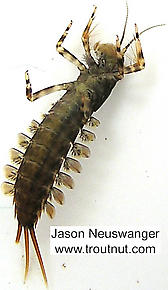 View 4 Pictures
View 4 Pictures
 View 4 Pictures
View 4 PicturesCollected February 7, 2004 from the Namekagon River in Wisconsin
Added to Troutnut.com by Troutnut on January 25, 2006
Added to Troutnut.com by Troutnut on January 25, 2006
Ephemerella subvaria (Hendrickson) Mayfly Nymph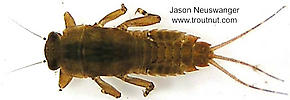 View 3 PicturesHere's another nymph with the strange brownish coloring rather than the olive I usually see for subvaria. I suspect it's the same species and it's just wide individual variation.
View 3 PicturesHere's another nymph with the strange brownish coloring rather than the olive I usually see for subvaria. I suspect it's the same species and it's just wide individual variation.
 View 3 PicturesHere's another nymph with the strange brownish coloring rather than the olive I usually see for subvaria. I suspect it's the same species and it's just wide individual variation.
View 3 PicturesHere's another nymph with the strange brownish coloring rather than the olive I usually see for subvaria. I suspect it's the same species and it's just wide individual variation.Collected February 7, 2004 from unknown in Wisconsin
Added to Troutnut.com by Troutnut on January 25, 2006
Added to Troutnut.com by Troutnut on January 25, 2006
Ephemerella invaria (Sulphur Dun) Mayfly Nymph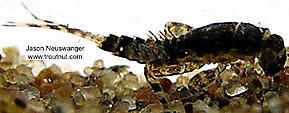 View 4 PicturesI looked at this nymph closely under a microscope to ascertain some key features I was wondering about in previous photographs of similar specimens. It definitely does have the fan-tail characteristic of the Ephemerella genus. It also has strongly 2-banded tibiae (
View 4 PicturesI looked at this nymph closely under a microscope to ascertain some key features I was wondering about in previous photographs of similar specimens. It definitely does have the fan-tail characteristic of the Ephemerella genus. It also has strongly 2-banded tibiae ( Tibia: A middle segments in the leg of an insect, located between the femur and the tarsus.) and definite tiny abdominal tubercles (
Tibia: A middle segments in the leg of an insect, located between the femur and the tarsus.) and definite tiny abdominal tubercles ( Tubercle: Various peculiar little bumps or projections on an insect. Their character is important for the identification of many kinds of insects, such as the nymphs of Ephemerellidae mayflies.).
Tubercle: Various peculiar little bumps or projections on an insect. Their character is important for the identification of many kinds of insects, such as the nymphs of Ephemerellidae mayflies.).
 View 4 PicturesI looked at this nymph closely under a microscope to ascertain some key features I was wondering about in previous photographs of similar specimens. It definitely does have the fan-tail characteristic of the Ephemerella genus. It also has strongly 2-banded tibiae (
View 4 PicturesI looked at this nymph closely under a microscope to ascertain some key features I was wondering about in previous photographs of similar specimens. It definitely does have the fan-tail characteristic of the Ephemerella genus. It also has strongly 2-banded tibiae (
The tibia of this Isonychia bicolor mayfly spinner is highlighted in red.

A few (not all) of the abdominal tubercles on this Ephemerella needhami nymph are circled. They are especially large in this species.
Collected February 7, 2004 from unknown in Wisconsin
Added to Troutnut.com by Troutnut on January 25, 2006
Added to Troutnut.com by Troutnut on January 25, 2006
Baetidae (Blue-Winged Olives) Mayfly Nymph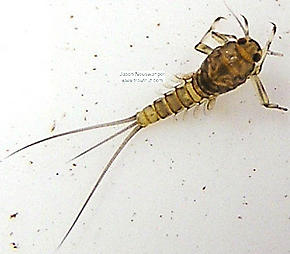 View 3 Pictures
View 3 Pictures
 View 3 Pictures
View 3 PicturesCollected February 7, 2004 from unknown in Wisconsin
Added to Troutnut.com by Troutnut on January 25, 2006
Added to Troutnut.com by Troutnut on January 25, 2006
Ephemerella subvaria (Hendrickson) Mayfly Nymph View 3 PicturesThis is another peculiar brownish Ephemerella. It has double-banded tibiae (
View 3 PicturesThis is another peculiar brownish Ephemerella. It has double-banded tibiae ( Tibia: A middle segments in the leg of an insect, located between the femur and the tarsus.) and prominent black-fringed tubercles (
Tibia: A middle segments in the leg of an insect, located between the femur and the tarsus.) and prominent black-fringed tubercles ( Tubercle: Various peculiar little bumps or projections on an insect. Their character is important for the identification of many kinds of insects, such as the nymphs of Ephemerellidae mayflies.).
Tubercle: Various peculiar little bumps or projections on an insect. Their character is important for the identification of many kinds of insects, such as the nymphs of Ephemerellidae mayflies.).
 View 3 PicturesThis is another peculiar brownish Ephemerella. It has double-banded tibiae (
View 3 PicturesThis is another peculiar brownish Ephemerella. It has double-banded tibiae (
The tibia of this Isonychia bicolor mayfly spinner is highlighted in red.

A few (not all) of the abdominal tubercles on this Ephemerella needhami nymph are circled. They are especially large in this species.
Collected February 7, 2004 from unknown in Wisconsin
Added to Troutnut.com by Troutnut on January 25, 2006
Added to Troutnut.com by Troutnut on January 25, 2006
Baetidae (Blue-Winged Olives) Mayfly Nymph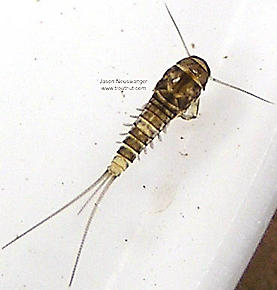 View 3 PicturesThis specimen has indistinct gill veinlets (Veinlet: Short insect wing veins connecting the major longitudinal veins to the wing margin.), a rounded seventh gill, and no bands on the tails.
View 3 PicturesThis specimen has indistinct gill veinlets (Veinlet: Short insect wing veins connecting the major longitudinal veins to the wing margin.), a rounded seventh gill, and no bands on the tails.
 View 3 PicturesThis specimen has indistinct gill veinlets (Veinlet: Short insect wing veins connecting the major longitudinal veins to the wing margin.), a rounded seventh gill, and no bands on the tails.
View 3 PicturesThis specimen has indistinct gill veinlets (Veinlet: Short insect wing veins connecting the major longitudinal veins to the wing margin.), a rounded seventh gill, and no bands on the tails.Collected February 7, 2004 from unknown in Wisconsin
Added to Troutnut.com by Troutnut on January 25, 2006
Added to Troutnut.com by Troutnut on January 25, 2006
Caenis (Angler's Curses) Mayfly Nymph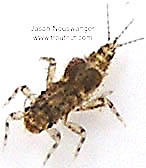 View 3 Pictures
View 3 Pictures
 View 3 Pictures
View 3 PicturesCollected February 7, 2004 from unknown in Wisconsin
Added to Troutnut.com by Troutnut on January 25, 2006
Added to Troutnut.com by Troutnut on January 25, 2006
Epeorus vitreus (Sulphur) Mayfly Nymph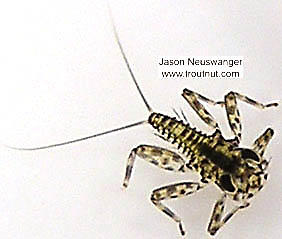 View 3 PicturesKey features I discerned with a microscope include that the femoral flange is sharp, and the first gill is not extended.
View 3 PicturesKey features I discerned with a microscope include that the femoral flange is sharp, and the first gill is not extended.
 View 3 PicturesKey features I discerned with a microscope include that the femoral flange is sharp, and the first gill is not extended.
View 3 PicturesKey features I discerned with a microscope include that the femoral flange is sharp, and the first gill is not extended.Collected February 7, 2004 from unknown in Wisconsin
Added to Troutnut.com by Troutnut on January 25, 2006
Added to Troutnut.com by Troutnut on January 25, 2006
Eurylophella (Chocolate Duns) Mayfly Nymph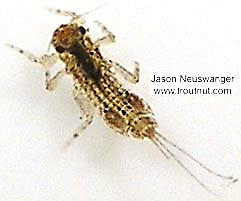 View 3 Pictures
View 3 Pictures
 View 3 Pictures
View 3 PicturesCollected February 7, 2004 from unknown in Wisconsin
Added to Troutnut.com by Troutnut on January 25, 2006
Added to Troutnut.com by Troutnut on January 25, 2006
Eurylophella (Chocolate Duns) Mayfly Nymph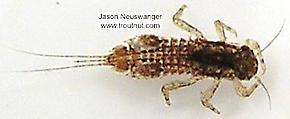 View 3 PicturesLooking at this specimen under a microscope revealed prominent sharp abdominal tubercles (
View 3 PicturesLooking at this specimen under a microscope revealed prominent sharp abdominal tubercles ( Tubercle: Various peculiar little bumps or projections on an insect. Their character is important for the identification of many kinds of insects, such as the nymphs of Ephemerellidae mayflies.). Also, abdominal segment 9 is distinctly longer than abdominal segment 8, meaning this is definitely a Eurylophella nymph.
Tubercle: Various peculiar little bumps or projections on an insect. Their character is important for the identification of many kinds of insects, such as the nymphs of Ephemerellidae mayflies.). Also, abdominal segment 9 is distinctly longer than abdominal segment 8, meaning this is definitely a Eurylophella nymph.
 View 3 PicturesLooking at this specimen under a microscope revealed prominent sharp abdominal tubercles (
View 3 PicturesLooking at this specimen under a microscope revealed prominent sharp abdominal tubercles (
A few (not all) of the abdominal tubercles on this Ephemerella needhami nymph are circled. They are especially large in this species.
Collected February 7, 2004 from unknown in Wisconsin
Added to Troutnut.com by Troutnut on January 25, 2006
Added to Troutnut.com by Troutnut on January 25, 2006
Eurylophella (Chocolate Duns) Mayfly Nymph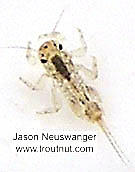 View 3 PicturesThis nymph is an extremely early instar (Instar: Many invertebrates molt through dozens of progressively larger and better-developed stages as they grow. Each of these stages is known as an instar. Hard-bodied nymphs typically molt through more instars than soft-bodied larvae.).
View 3 PicturesThis nymph is an extremely early instar (Instar: Many invertebrates molt through dozens of progressively larger and better-developed stages as they grow. Each of these stages is known as an instar. Hard-bodied nymphs typically molt through more instars than soft-bodied larvae.).
 View 3 PicturesThis nymph is an extremely early instar (Instar: Many invertebrates molt through dozens of progressively larger and better-developed stages as they grow. Each of these stages is known as an instar. Hard-bodied nymphs typically molt through more instars than soft-bodied larvae.).
View 3 PicturesThis nymph is an extremely early instar (Instar: Many invertebrates molt through dozens of progressively larger and better-developed stages as they grow. Each of these stages is known as an instar. Hard-bodied nymphs typically molt through more instars than soft-bodied larvae.).Collected February 7, 2004 from unknown in Wisconsin
Added to Troutnut.com by Troutnut on January 25, 2006
Added to Troutnut.com by Troutnut on January 25, 2006
Eurylophella (Chocolate Duns) Mayfly Nymph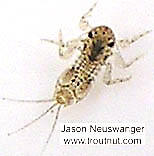 View 3 PicturesThis nymph is an extremely early instar (Instar: Many invertebrates molt through dozens of progressively larger and better-developed stages as they grow. Each of these stages is known as an instar. Hard-bodied nymphs typically molt through more instars than soft-bodied larvae.).
View 3 PicturesThis nymph is an extremely early instar (Instar: Many invertebrates molt through dozens of progressively larger and better-developed stages as they grow. Each of these stages is known as an instar. Hard-bodied nymphs typically molt through more instars than soft-bodied larvae.).
 View 3 PicturesThis nymph is an extremely early instar (Instar: Many invertebrates molt through dozens of progressively larger and better-developed stages as they grow. Each of these stages is known as an instar. Hard-bodied nymphs typically molt through more instars than soft-bodied larvae.).
View 3 PicturesThis nymph is an extremely early instar (Instar: Many invertebrates molt through dozens of progressively larger and better-developed stages as they grow. Each of these stages is known as an instar. Hard-bodied nymphs typically molt through more instars than soft-bodied larvae.).Collected February 7, 2004 from unknown in Wisconsin
Added to Troutnut.com by Troutnut on January 25, 2006
Added to Troutnut.com by Troutnut on January 25, 2006
Ephemerella subvaria (Hendrickson) Mayfly Nymph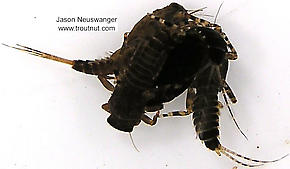 View 3 PicturesHere are the 4 main color variations I've found that I'm considering to be E. subvaria.
View 3 PicturesHere are the 4 main color variations I've found that I'm considering to be E. subvaria.
 View 3 PicturesHere are the 4 main color variations I've found that I'm considering to be E. subvaria.
View 3 PicturesHere are the 4 main color variations I've found that I'm considering to be E. subvaria.Collected February 7, 2004 from unknown in Wisconsin
Added to Troutnut.com by Troutnut on January 25, 2006
Added to Troutnut.com by Troutnut on January 25, 2006
Eurylophella (Chocolate Duns) Mayfly Nymph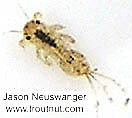 View 3 PicturesThis nymph is an extremely early instar (Instar: Many invertebrates molt through dozens of progressively larger and better-developed stages as they grow. Each of these stages is known as an instar. Hard-bodied nymphs typically molt through more instars than soft-bodied larvae.).
View 3 PicturesThis nymph is an extremely early instar (Instar: Many invertebrates molt through dozens of progressively larger and better-developed stages as they grow. Each of these stages is known as an instar. Hard-bodied nymphs typically molt through more instars than soft-bodied larvae.).
 View 3 PicturesThis nymph is an extremely early instar (Instar: Many invertebrates molt through dozens of progressively larger and better-developed stages as they grow. Each of these stages is known as an instar. Hard-bodied nymphs typically molt through more instars than soft-bodied larvae.).
View 3 PicturesThis nymph is an extremely early instar (Instar: Many invertebrates molt through dozens of progressively larger and better-developed stages as they grow. Each of these stages is known as an instar. Hard-bodied nymphs typically molt through more instars than soft-bodied larvae.).Collected February 7, 2004 from unknown in Wisconsin
Added to Troutnut.com by Troutnut on January 25, 2006
Added to Troutnut.com by Troutnut on January 25, 2006
Clitelatta-Oligochaeta (Worms) Worm Adult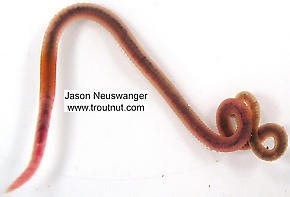 View 2 PicturesI know most people know what a worm looks like, but when trying to tie an imitation, the memory is often a poor source of accurate color information, and a picture helps to get the right shade. One thing that surprised me in my sampling is that quite a few worms did turn up. Before I was a fly fisherman, when I used worms for bait, I always thought they were merely a tantalizing morsel and not a regular trout food, but I've since realized that there are quite a few worms that live in the sediment on a stream bottom.
View 2 PicturesI know most people know what a worm looks like, but when trying to tie an imitation, the memory is often a poor source of accurate color information, and a picture helps to get the right shade. One thing that surprised me in my sampling is that quite a few worms did turn up. Before I was a fly fisherman, when I used worms for bait, I always thought they were merely a tantalizing morsel and not a regular trout food, but I've since realized that there are quite a few worms that live in the sediment on a stream bottom.
 View 2 PicturesI know most people know what a worm looks like, but when trying to tie an imitation, the memory is often a poor source of accurate color information, and a picture helps to get the right shade. One thing that surprised me in my sampling is that quite a few worms did turn up. Before I was a fly fisherman, when I used worms for bait, I always thought they were merely a tantalizing morsel and not a regular trout food, but I've since realized that there are quite a few worms that live in the sediment on a stream bottom.
View 2 PicturesI know most people know what a worm looks like, but when trying to tie an imitation, the memory is often a poor source of accurate color information, and a picture helps to get the right shade. One thing that surprised me in my sampling is that quite a few worms did turn up. Before I was a fly fisherman, when I used worms for bait, I always thought they were merely a tantalizing morsel and not a regular trout food, but I've since realized that there are quite a few worms that live in the sediment on a stream bottom.Collected February 7, 2004 from unknown in Wisconsin
Added to Troutnut.com by Troutnut on January 25, 2006
Added to Troutnut.com by Troutnut on January 25, 2006
Perlidae (Golden Stones) Stonefly Nymph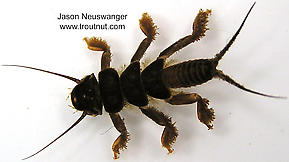 View 2 Pictures
View 2 Pictures
 View 2 Pictures
View 2 PicturesCollected February 7, 2004 from unknown in Wisconsin
Added to Troutnut.com by Troutnut on January 25, 2006
Added to Troutnut.com by Troutnut on January 25, 2006
Perlidae (Golden Stones) Stonefly Nymph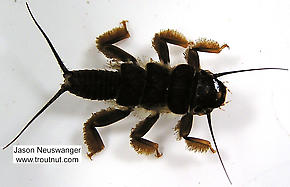 View 2 Pictures
View 2 Pictures
 View 2 Pictures
View 2 PicturesCollected February 7, 2004 from unknown in Wisconsin
Added to Troutnut.com by Troutnut on January 25, 2006
Added to Troutnut.com by Troutnut on January 25, 2006
Taeniopteryx (Early Black Stoneflies) Stonefly Nymph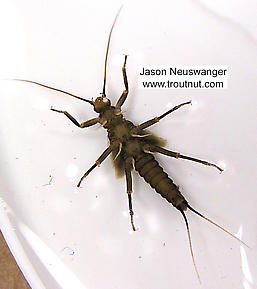 View 2 Pictures
View 2 Pictures
 View 2 Pictures
View 2 PicturesCollected February 7, 2004 from unknown in Wisconsin
Added to Troutnut.com by Troutnut on January 25, 2006
Added to Troutnut.com by Troutnut on January 25, 2006
Epeorus vitreus (Sulphur) Mayfly Nymph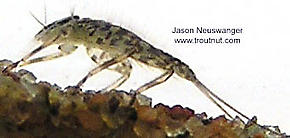 View 3 PicturesKey features I discerned with a microscope include that the femoral flange is blunt (later note: on nymphs of this size, it's somewhat ambiguous and the femora (
View 3 PicturesKey features I discerned with a microscope include that the femoral flange is blunt (later note: on nymphs of this size, it's somewhat ambiguous and the femora (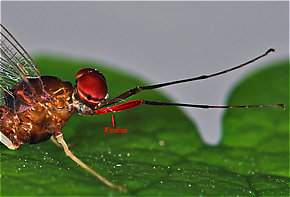 Femur: The main segment of an insect's leg close to the body, in between the tibia and the trochanter.) can be damaged in the collection process), the postero-lateral (Lateral: To the side.) spines have a longer anterior (Anterior: Toward the front of an organism's body. The phrase "anterior to" means "in front of."), the first gill is not extended, all gills are tracheated, and the femora (
Femur: The main segment of an insect's leg close to the body, in between the tibia and the trochanter.) can be damaged in the collection process), the postero-lateral (Lateral: To the side.) spines have a longer anterior (Anterior: Toward the front of an organism's body. The phrase "anterior to" means "in front of."), the first gill is not extended, all gills are tracheated, and the femora ( Femur: The main segment of an insect's leg close to the body, in between the tibia and the trochanter.) have a distinctive brown spot on the center while all the other spots are gray.
Femur: The main segment of an insect's leg close to the body, in between the tibia and the trochanter.) have a distinctive brown spot on the center while all the other spots are gray.
 View 3 PicturesKey features I discerned with a microscope include that the femoral flange is blunt (later note: on nymphs of this size, it's somewhat ambiguous and the femora (
View 3 PicturesKey features I discerned with a microscope include that the femoral flange is blunt (later note: on nymphs of this size, it's somewhat ambiguous and the femora (
The femur of this Isonychia bicolor mayfly spinner is highlighted in red.

The femur of this Isonychia bicolor mayfly spinner is highlighted in red.
Collected February 7, 2004 from unknown in Wisconsin
Added to Troutnut.com by Troutnut on January 25, 2006
Added to Troutnut.com by Troutnut on January 25, 2006
Baetidae (Blue-Winged Olives) Mayfly Nymph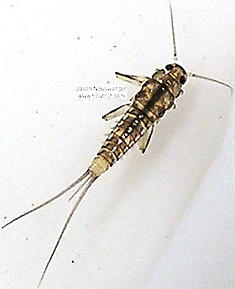 View 2 PicturesThis nymph has gills with indistinct veinlets (Veinlet: Short insect wing veins connecting the major longitudinal veins to the wing margin.), segments 5, 9, and 10 pale, a rounded 7th gill, and a very short middle tail.
View 2 PicturesThis nymph has gills with indistinct veinlets (Veinlet: Short insect wing veins connecting the major longitudinal veins to the wing margin.), segments 5, 9, and 10 pale, a rounded 7th gill, and a very short middle tail.
 View 2 PicturesThis nymph has gills with indistinct veinlets (Veinlet: Short insect wing veins connecting the major longitudinal veins to the wing margin.), segments 5, 9, and 10 pale, a rounded 7th gill, and a very short middle tail.
View 2 PicturesThis nymph has gills with indistinct veinlets (Veinlet: Short insect wing veins connecting the major longitudinal veins to the wing margin.), segments 5, 9, and 10 pale, a rounded 7th gill, and a very short middle tail.Collected February 7, 2004 from unknown in Wisconsin
Added to Troutnut.com by Troutnut on January 25, 2006
Added to Troutnut.com by Troutnut on January 25, 2006
Epeorus vitreus (Sulphur) Mayfly Nymph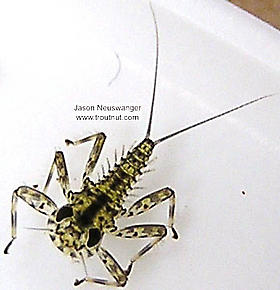 View 2 PicturesKey features I discerned with a microscope include that the femoral flange is blunt (again, given the other features and location, I probably misread this one), postero-lateral (Lateral: To the side.) spines with the anterior (Anterior: Toward the front of an organism's body. The phrase "anterior to" means "in front of.") longer, and the first gill is not extended.
View 2 PicturesKey features I discerned with a microscope include that the femoral flange is blunt (again, given the other features and location, I probably misread this one), postero-lateral (Lateral: To the side.) spines with the anterior (Anterior: Toward the front of an organism's body. The phrase "anterior to" means "in front of.") longer, and the first gill is not extended.
 View 2 PicturesKey features I discerned with a microscope include that the femoral flange is blunt (again, given the other features and location, I probably misread this one), postero-lateral (Lateral: To the side.) spines with the anterior (Anterior: Toward the front of an organism's body. The phrase "anterior to" means "in front of.") longer, and the first gill is not extended.
View 2 PicturesKey features I discerned with a microscope include that the femoral flange is blunt (again, given the other features and location, I probably misread this one), postero-lateral (Lateral: To the side.) spines with the anterior (Anterior: Toward the front of an organism's body. The phrase "anterior to" means "in front of.") longer, and the first gill is not extended.Collected February 7, 2004 from unknown in Wisconsin
Added to Troutnut.com by Troutnut on January 25, 2006
Added to Troutnut.com by Troutnut on January 25, 2006
Epeorus vitreus (Sulphur) Mayfly Nymph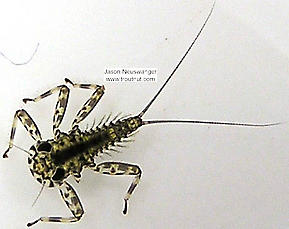 View 2 Pictures
View 2 Pictures
 View 2 Pictures
View 2 PicturesCollected February 7, 2004 from unknown in Wisconsin
Added to Troutnut.com by Troutnut on January 25, 2006
Added to Troutnut.com by Troutnut on January 25, 2006
Epeorus vitreus (Sulphur) Mayfly Nymph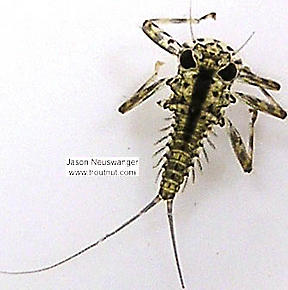 View 2 Pictures
View 2 Pictures
 View 2 Pictures
View 2 PicturesCollected February 7, 2004 from unknown in Wisconsin
Added to Troutnut.com by Troutnut on January 25, 2006
Added to Troutnut.com by Troutnut on January 25, 2006
Hydropsychidae Caddisfly Larva View 2 Pictures
View 2 Pictures
 View 2 Pictures
View 2 PicturesCollected February 7, 2004 from unknown in Wisconsin
Added to Troutnut.com by Troutnut on January 25, 2006
Added to Troutnut.com by Troutnut on January 25, 2006
Acari (Mites) Mite Adult View 2 Pictures
View 2 Pictures
 View 2 Pictures
View 2 PicturesCollected February 7, 2004 from unknown in Wisconsin
Added to Troutnut.com by Troutnut on January 25, 2006
Added to Troutnut.com by Troutnut on January 25, 2006
Baetidae (Blue-Winged Olives) Mayfly Nymph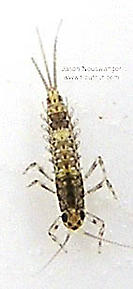 View 3 PicturesClose examination under a microscope revealed that this Baetid nymph has segment 5 pale, segments 8, 9, and 10 pale but less so, a middle tail almost as long as the outer tails, conspicuous gill veinlets (Veinlet: Short insect wing veins connecting the major longitudinal veins to the wing margin.), no bands on its tails, and pointed, slender 7th gills.
View 3 PicturesClose examination under a microscope revealed that this Baetid nymph has segment 5 pale, segments 8, 9, and 10 pale but less so, a middle tail almost as long as the outer tails, conspicuous gill veinlets (Veinlet: Short insect wing veins connecting the major longitudinal veins to the wing margin.), no bands on its tails, and pointed, slender 7th gills.
 View 3 PicturesClose examination under a microscope revealed that this Baetid nymph has segment 5 pale, segments 8, 9, and 10 pale but less so, a middle tail almost as long as the outer tails, conspicuous gill veinlets (Veinlet: Short insect wing veins connecting the major longitudinal veins to the wing margin.), no bands on its tails, and pointed, slender 7th gills.
View 3 PicturesClose examination under a microscope revealed that this Baetid nymph has segment 5 pale, segments 8, 9, and 10 pale but less so, a middle tail almost as long as the outer tails, conspicuous gill veinlets (Veinlet: Short insect wing veins connecting the major longitudinal veins to the wing margin.), no bands on its tails, and pointed, slender 7th gills.Collected February 7, 2004 from unknown in Wisconsin
Added to Troutnut.com by Troutnut on January 25, 2006
Added to Troutnut.com by Troutnut on January 25, 2006
Maccaffertium (March Browns and Cahills) Mayfly Nymph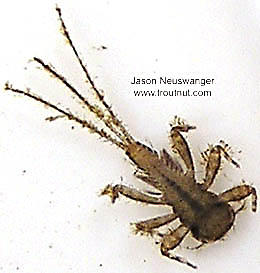 View 2 PicturesI saw under a microscope that the gills on this specimen aren't tracheated.
View 2 PicturesI saw under a microscope that the gills on this specimen aren't tracheated.
 View 2 PicturesI saw under a microscope that the gills on this specimen aren't tracheated.
View 2 PicturesI saw under a microscope that the gills on this specimen aren't tracheated.Collected February 7, 2004 from unknown in Wisconsin
Added to Troutnut.com by Troutnut on January 25, 2006
Added to Troutnut.com by Troutnut on January 25, 2006
Most recent comments on this post (latest on top)
Comment on this post
Top 10 Fly Hatches
Top Gift Shop Designs
Eat mayflies.
Top Insect Specimens
Miscellaneous Sites
Troutnut.com is copyright © 2004-2024 Jason
Neuswanger (email Jason). See my FAQ for information about use of my images.
 privacy policy
privacy policy
